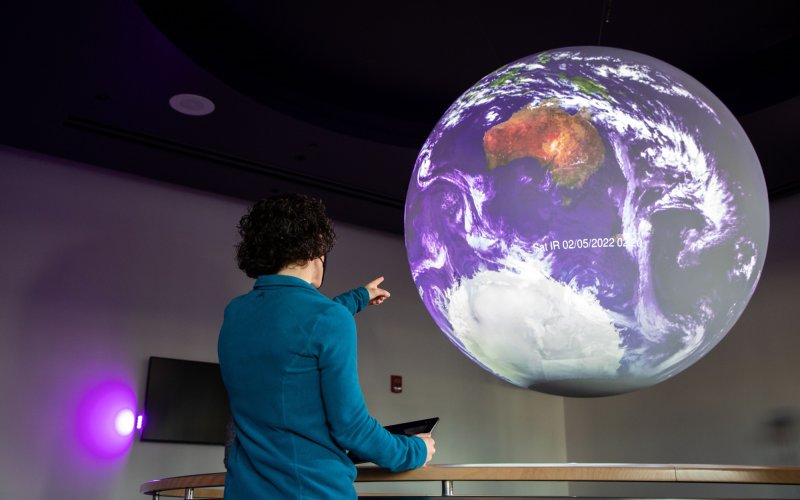UAlbany Launches New Undergraduate Program in Climate Science

By Mike Nolan
ALBANY, N.Y. (Sept. 3, 2024) — A new undergraduate program launching this semester at the University at Albany will prepare students to better understand and address the wide-ranging challenges related to Earth’s changing climate.
UAlbany’s new BS in Climate Science, offered through the Department of Atmospheric and Environmental Sciences (DAES) at the College of Arts and Sciences, has been approved by the New York State Department of Education and is now accepting students.
This science-centered program offers a holistic view of Earth's climate. Students will learn how different parts of the Earth system (atmosphere, ocean, lithosphere, biosphere) interact to shape our climate and impact society. They’ll also become proficient in using key climate science tools such as climate modeling, data analysis and statistics.
The new major adds to DAES undergraduate degree programs in atmospheric science and interdisciplinary studies (concentration in environmental science).
“This new program will broaden our offerings and engage students in an area that has grown in interest and importance worldwide,” said College of Arts and Sciences Dean Jeanette Altarriba. “It offers a unique opportunity to gain knowledge and experience from some of the leading experts in the field of climate science and to study weather and related phenomena in the field, firsthand, both within the classroom and at various sites in and around the Capital Region.”
“This new program will replace our climate change specialization allowing for a deeper and more holistic education on this important topic," said DAES Chair and Professor Ryan Torn. “Like the climate change specialization it is replacing, this new program is interdisciplinary and will give our students an even better understanding of climate and climate change needed to address the critical challenges it poses to New Yorkers and society at large.”
The Science of Climate Change
Research shows that 3.6 billion people already live in areas highly susceptible to climate change. In 2023, the U.S. experienced 28 separate weather and climate disasters costing at least 1 billion dollars in damage, ranking as the highest number of billion-dollar disasters in a recorded calendar year.
In February, New York released its Climate Impacts Assessment, which breaks down how climate change will impact the state economy. The report projects that average temperatures will increase in all regions of the state by about 5 to 11 degrees Fahrenheit by the end of the century, making New York’s climate more like Virginia’s by 2030.
Justin Minder, DAES associate professor and undergraduate program director, says the new climate science program is designed to focus on climate change causes, impacts and solutions.
“The study of climate science is critical for the future of our community, our state and the world,” Minder said. “Events like Hurricane Irene, Superstorm Sandy, and last year’s Canadian wildfires have shown that New York is not immune to the effects of extreme weather. We need more individuals who understand climate science and can research the impacts of our changing climate and inform policy decisions.”
A Hub for Climate, Weather and Emergency Preparedness
Outside of the classroom, students will be offered hands-on research opportunities at UAlbany’s ETEC building, a $180 million facility that serves as a hub for weather, climate and emergency preparedness researchers and educators.
Among its many feature spaces are the New York State Mesonet, a statewide weather observation network operated by UAlbany, the xCITE lab, a state-of-the-art data and visual analytics center that connects weather and climate research with emerging tech, the Paleoclimate lab, which studies Earth’s past climate conditions, a science-on-a-sphere room, weather research map rooms and a glass-enclosed weather observation deck.
Students will also learn about how engineering and design can contribute to climate solutions from tours of ETEC, which received LEED Platinum certification, the highest level of certification awarded by the U.S. Green Building Council for energy-efficient and sustainable buildings.
In addition, they’ll have opportunities for private sector internships in climate analytics facilitated through UAlbany’s Center of Excellence in Weather and Climate Analytics, along with international research experiences via programs like PIRE-CREATE.
“Our program will be the first climate science degree within SUNY, and one of the only ones in all of New York, that specifically prepares students to tackle this complex challenge,” Minder said.
The four-year program requires 72 credits and can be taken on a full- or part-time basis.




